Investigating the Sanding Process of Medium-Density Fiberboard and Korean Pine for Material Removal and Surface Creation
Abstract
:1. Introduction
2. Materials and Methods
2.1. Experimental Setup
2.2. Single Grit and Workpiece Preparation
2.3. The Scratch Direction aAnd Scratch Profile Measurement
2.4. The Grey Relational Grade Analysis (GRGA)
3. Results and Discussion
3.1. The Plastic Material Deformation of Scratch Cut by Single Grit
3.2. The Elastic Spring Back Effect During Single Grit Grinding
4. Conclusions
Author Contributions
Funding
Acknowledgments
Conflicts of Interest
References
- Ratnasingam, J.; Reid, H.; Perkins, M. The abrasive grinding of rubberwood (Hevea brasiliensis): An industrial perspective. Eur. J. Wood Prod. 2002, 60, 191–196. [Google Scholar] [CrossRef]
- Bao, X.; Ying, J.H.; Cheng, F.; Zhang, J.; Luo, B.; Li, L.; Liu, H.G. Research on neural network model of surface roughness in belt grinding process for Pinus koraiensis. Measurement 2018, 115, 11–18. [Google Scholar] [CrossRef]
- Sulaiman, O.; Hashim, R.; Subari, K.; Liang, C.K. Effect of grinding on surface roughness of rubberwood. J. Mater. Process. Technol. 2009, 209, 3949–3955. [Google Scholar] [CrossRef]
- Stewart, H.A. Some surfacing defects and problems related to wood moisture content. Wood Fiber 1980, 12, 175–182. [Google Scholar]
- Evans, P.H.; Cullis, I.; Kim, J.; Leung, H.L.; Hazneza, S.; Heady, R.D. Microstructure and mechanism of grain raising in Wood. Coatings 2017, 7, 135. [Google Scholar] [CrossRef]
- Koehler, A. Some observations on raised grain. Trans. Am. Soc. Mech. Eng. 1932, 54, 27–30. [Google Scholar]
- Taylor, J.B.; Carrano, A.L.; Lemaster, R.L. Quantification of process parameters in a wood sanding operation. For. Prod. J. 1999, 49, 41–46. [Google Scholar]
- Luo, B.; Li, L.; Liu, H.; Xu, M.; Xing, F. Analysis of sanding parameters, sanding force, normal force, power consumption, and surface roughness in sanding wood-based panels. Bioresources 2014, 9, 7494–7503. [Google Scholar] [CrossRef]
- Xu, M.; Li, L.; Wang, M.; Luo, B. Effects of surface roughness and wood grain on the friction coefficient of wooden materials for wood–wood frictional pair. Tribol. Trans. 2014, 57, 871–878. [Google Scholar] [CrossRef]
- Cool, J.; Hernández, R.E. Improving the sanding process of black spruce wood for surface quality and water-based coating adhesion. For. Prod. J. 2011, 61, 372–380. [Google Scholar] [CrossRef]
- Sun, Y.; Li, L. Effect on bonding strength of surface roughness of sanding wood. Wood Process. Mach. 2010, 21, 41–43. (In Chinese) [Google Scholar]
- Hahn, R.S. On the Mechanics of the grinding process under plunge cut conditions. J. Eng. Ind. 1966, 88, 72–80. [Google Scholar] [CrossRef]
- Klocke, F. Principles of cutting edge engagement. In Manufacturing Process 2: Grinding, Honing, Lapping; Kuchle, A., Ed.; Springer: Berlin/Heidelberg, Germany, 2009; pp. 3–16. [Google Scholar]
- Chen, X.; Öpöz, T.T. Simulation of grinding surface creation—A single grit approach. Adv. Mater. Res. 2010, 126–128, 23–28. [Google Scholar] [CrossRef]
- Anderson, D.; Warkentin, A.; Bauer, R. Comparison of spherical and truncated cone geometries for single abrasive-grain cutting. J. Mater. Process. Technol. 2012, 212, 1946–1953. [Google Scholar] [CrossRef]
- Rasim, M.; Mattfeld, P.; Klocke, F. Analysis of the grain shape influence on the chip formation in grinding. J. Mater. Process. Technol. 2015, 226, 60–68. [Google Scholar] [CrossRef]
- Öpöz, T.T.; Chen, X. Experimental investigation of material removal mechanism in single grit grinding. Int. J. Mach. Tools Manuf. 2012, 63, 32–40. [Google Scholar] [CrossRef]
- Ohtani, T.; Tanaka, C.; Usuki, H. Comparison of the heterogeneity of asperities in wood and aluminum grinding surfaces. Precis. Eng. 2004, 28, 58–64. [Google Scholar] [CrossRef]
- Gibson, L.J.; Ashby, M.F. Cellular Solids: Structure and Properties; Cambridge University Press: Cambridge, UK, 1988; p. 387. [Google Scholar]
- Lee, P.H.; Nam, J.S.; Li, C.; Sang, W.L. An experimental study on micro-grinding process with nanofluid minimum quantity lubrication (MQL). Int. J. Precis. Eng. Manuf. 2012, 13, 331–338. [Google Scholar] [CrossRef]
- Wang, S.; Li, C.; Zhang, X.; Zhou, D.; Zhang, D.; Zhang, Q. Modeling and simulation of the single grain grinding process of the nano-particle jet flow of minimal quantity lubrication. Open Mater. Sci. J. 2014, 8, 55–62. [Google Scholar] [CrossRef]
- Widsten, P. Oxidative Activation of Wood Fibers for The Manufacture of Medium-Density Fiberboard (MDF). Ph.D. Thesis, Helsinki University of Technology, Espoo, Finland, November 2002. [Google Scholar]
- Almeida, G.; Hernádez, R. Influence of the pore structure of wood on moisture desorption at high relative humidities. Wood Mater. Sci. Eng. 2007, 2, 33–44. [Google Scholar] [CrossRef]
- Andersson, S. A study of the Nanostructure of the Cell Wall of the Tracheids of Conifer Xylem by X-ray Scattering. Ph.D. Thesis, University of Helsinki, Helsinki, Finland, January 2007. [Google Scholar]
- Deng, J.L. Introduction to Grey system theory. J. Grey Syst. 1989, 1, 1–24. [Google Scholar]
- Ding, W.D.; Koubaa, A.; Chaala, A.; Belem, T.; Krause, C. Relationship between wood porosity, wood density and methyl methacrylate impregnation rate. Wood Mater. Sci. Eng. 2008, 3, 62–70. [Google Scholar] [CrossRef]
- Usta, I. Comparative study of wood density by specific amount of void volume (porosity). Turk. J. Agric. For. 2003, 27, 1–6. [Google Scholar]
- De Moura, L.F.; Hernández, R.E. Effects of abrasive mineral, grit size and feed speed on the quality of sanded surfaces of sugar maple wood. Wood Sci. Technol. 2006, 40, 517–530. [Google Scholar] [CrossRef]
- Tian, M.; Li, L. Study on influencing factors of sanding efficiency of abrasive belts in wood materials sanding. Wood Res. 2014, 59, 835–842. [Google Scholar]
- Stewart, H.A.; Crist, J.B. SEM examination of subsurface damage of wood after abrasive and knife planing. Wood Sci. 1982, 14, 106–109. [Google Scholar]
- De Meijer, M.; Thurich, K.; Militz, H. Comparative study on penetration characteristics of modern wood coatings. Wood Sci. Technol. 1998, 32, 347–365. [Google Scholar] [CrossRef]
- Hernández, R.E.; de Moura, L.F. Effects of knife jointing and wear on the planed surface quality of northern red oak wood. Wood Fiber Sci. 2002, 34, 540–552. [Google Scholar]
- De Moura, L.F.; Hernández, R.E. Evaluation of varnish coating performance for two surfacing methods on sugar maple wood. Wood Fiber Sci. 2005, 37, 355–366. [Google Scholar]
- Öpöz, T.T.; Chen, X. Experimental study on single grit grinding of Inconel 718. Proc. Inst. Mech. Eng. Part B J. Eng. Manuf. 2014, 229, 713–726. [Google Scholar] [CrossRef] [Green Version]

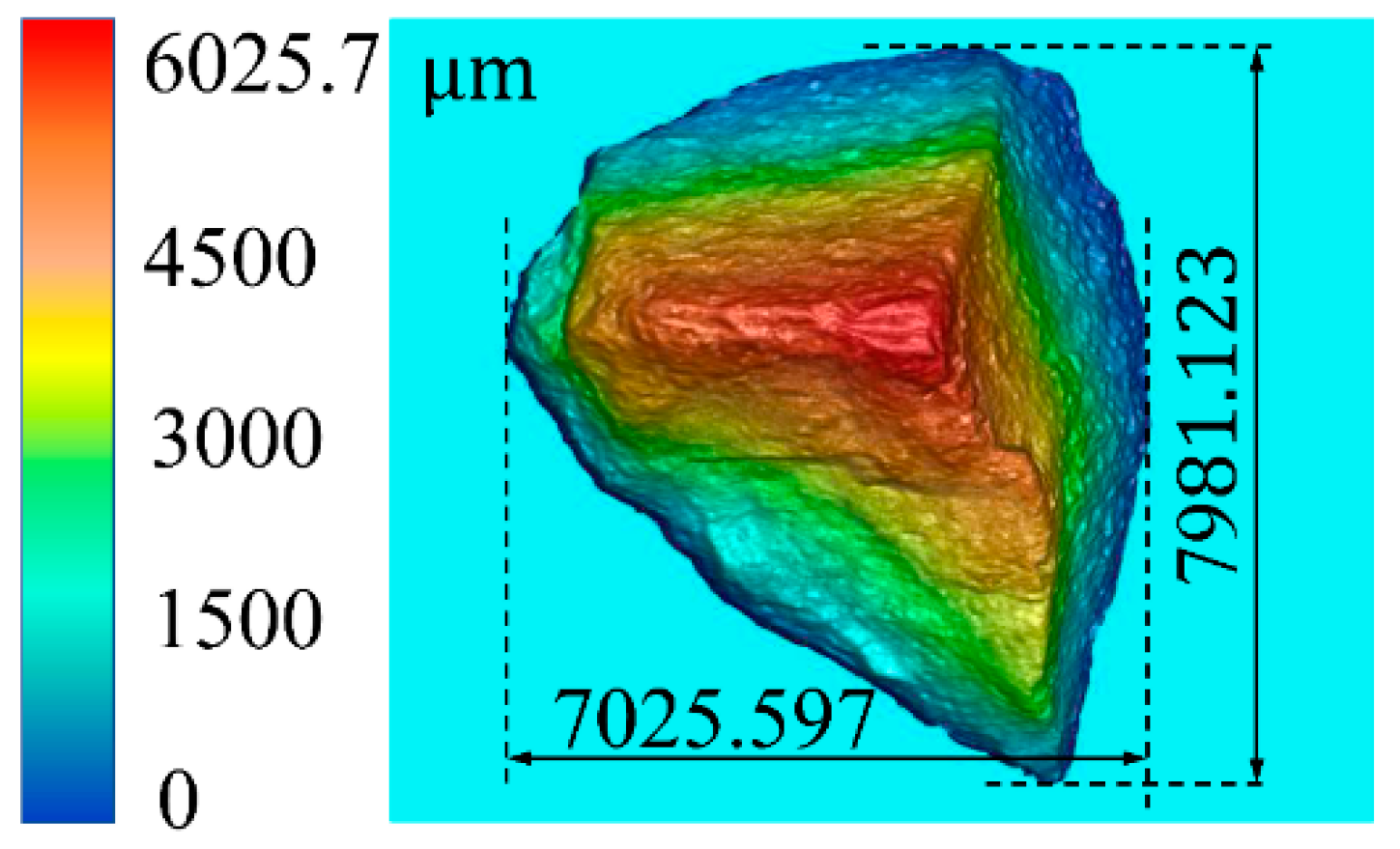

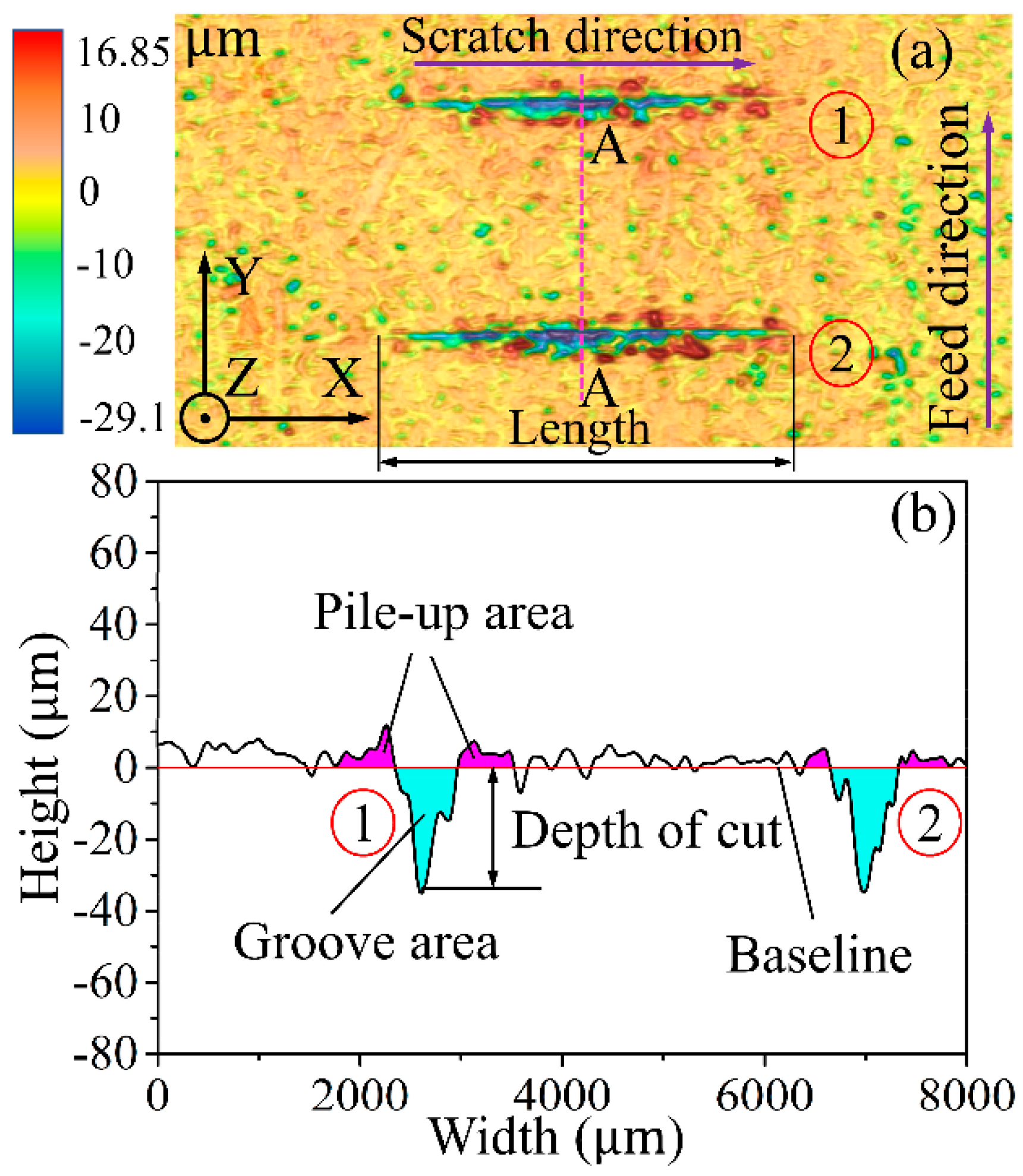


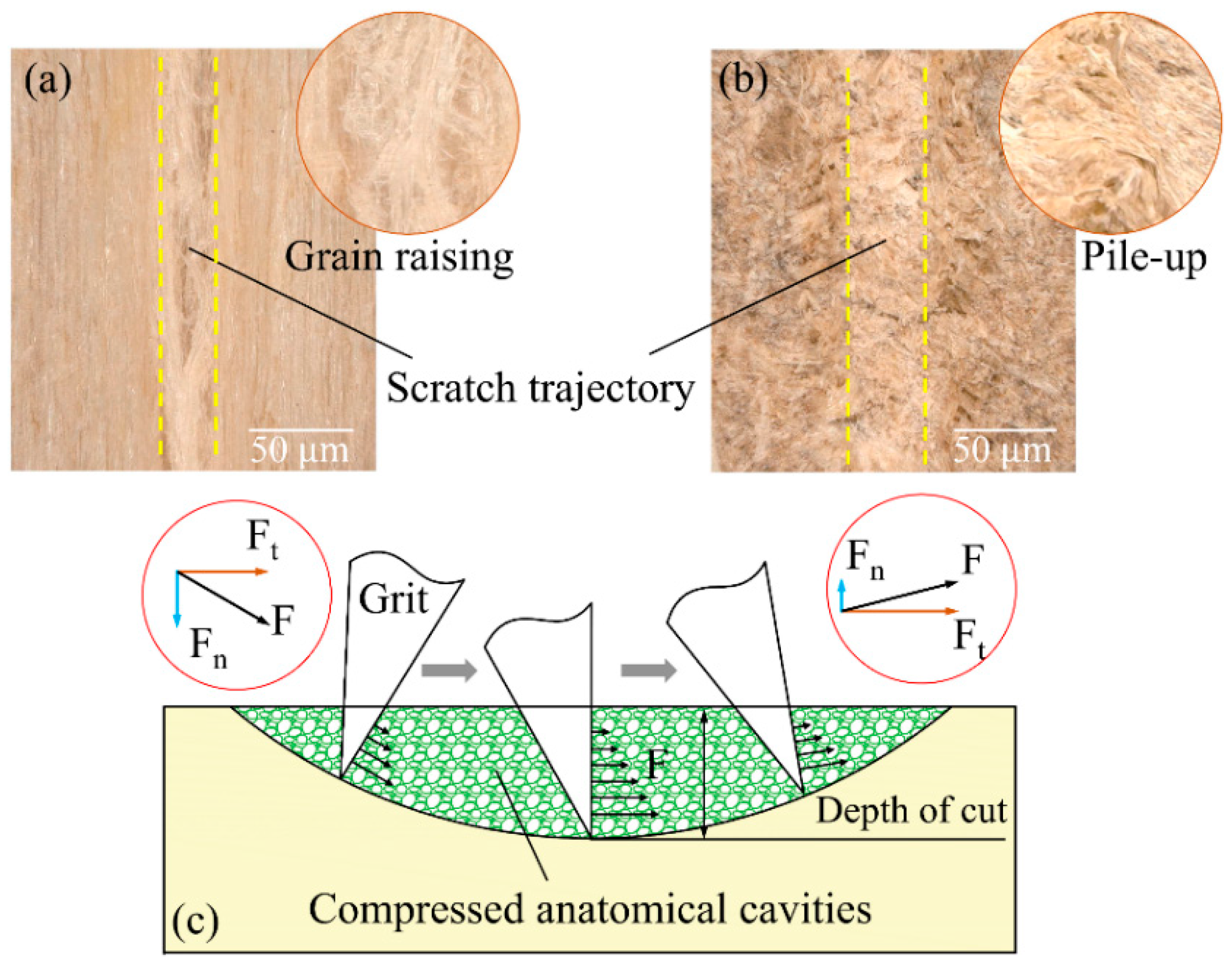

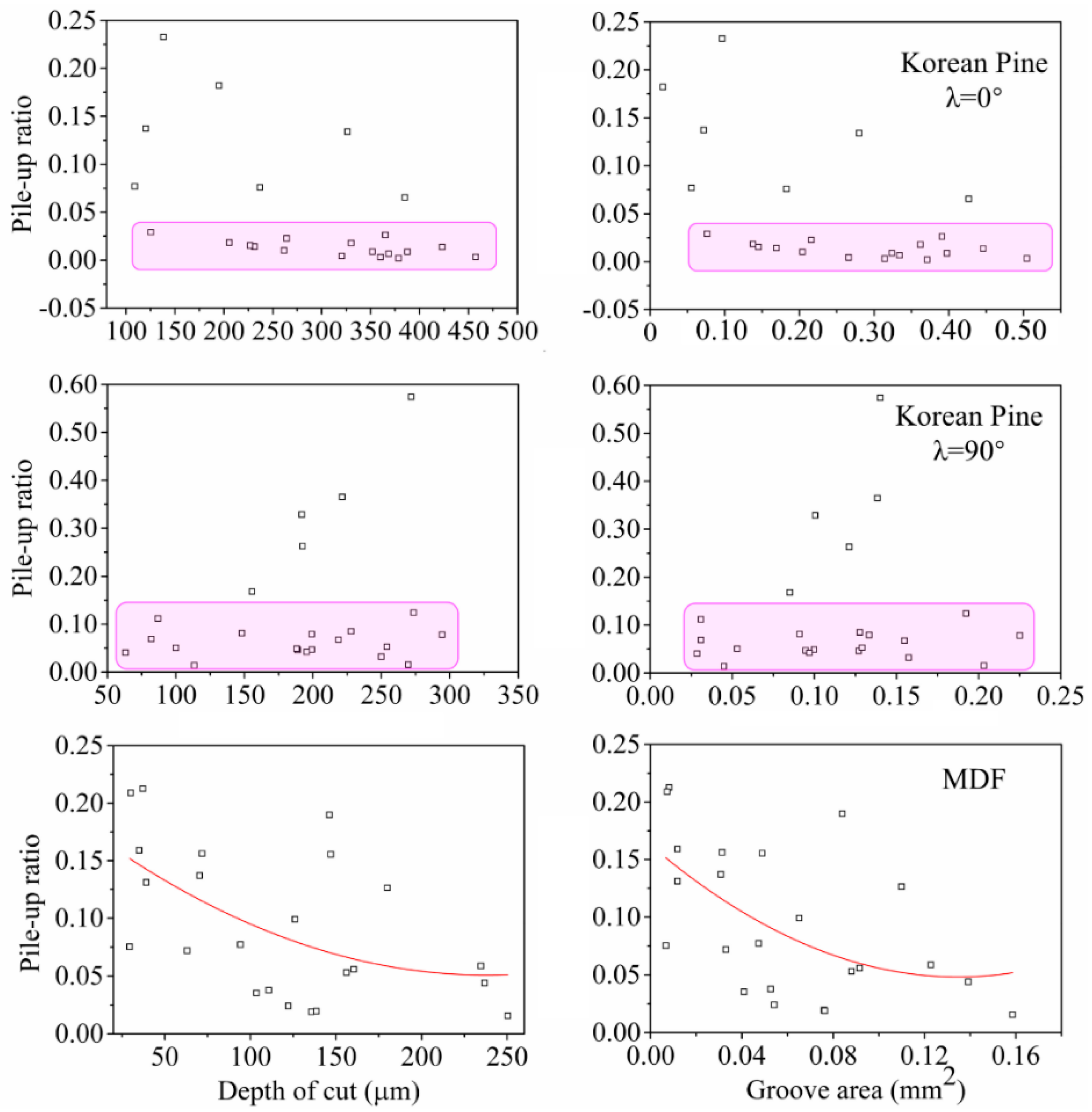

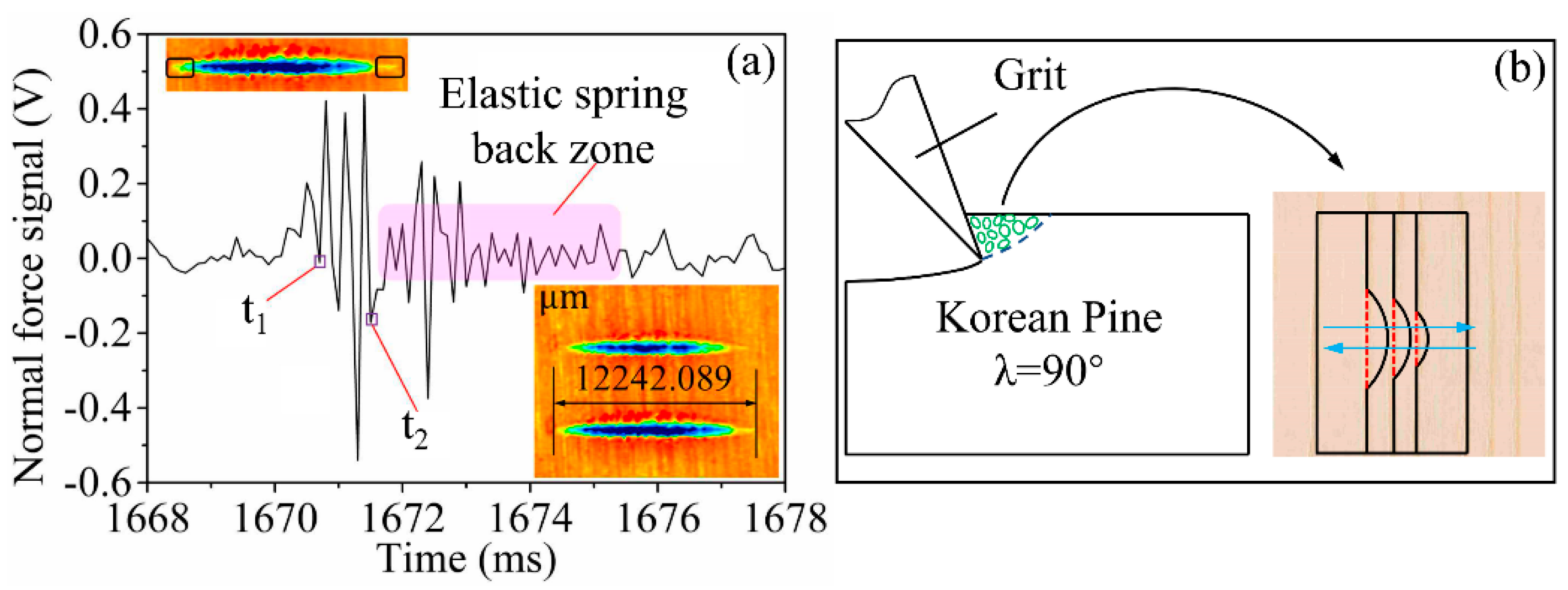
| Item | Description |
|---|---|
| Feed velocity | vw = 9 m/min |
| Cutting depth | 0–0.5 mm |
| Electrical spindle | The power is 1.5 kW, the speed is 2100 r/min, with 0.01 mm accuracy |
| Grinding wheel | Made of aluminum, 0.2 kg in weight, the diameter is 100 mm, with 0.012 coaxial accuracy |
| 3D force sensor | Sensitivity: FX ≈ 7.5 pC/N, FY ≈ −7.5 pC/N, FZ ≈ −3.7 pC/N |
| Charge amplifier | Measuring range is from ±100 pC to ±1,000,000 pC |
| No. | Item | Results |
|---|---|---|
| 1 | Mesh | 3 |
| 2 | Al2O3 | 95.0% |
| 3 | SiO2 | 1.0% |
| 4 | Fe | 0.2% |
| 5 | Ti | 2.0% |
| 6 | Density | 3.6 g/cm3 |
| 7 | Mohs’ hardness | ≥8.5 |
| Grey Comprehensive Relational Grade | Value | Rank |
|---|---|---|
| ρ01 | 0.5680 | 3 |
| ρ02 | 0.5230 | 4 |
| ρ03 | 0.5962 | 2 |
| ρ04 | 0.7504 | 1 |
| Comparison | L (μm) | L’ (μm) | ∆L = L – L’ (μm) |
|---|---|---|---|
| MDF | 10489.5 | 8641.6 | 1847.9 |
| Korean Pine (λ = 0°) | 18648.0 | 15332.0 | 3316.0 |
| Korean Pine (λ = 90°) | 16317.0 | 12242.1 | 4074.9 |
© 2018 by the authors. Licensee MDPI, Basel, Switzerland. This article is an open access article distributed under the terms and conditions of the Creative Commons Attribution (CC BY) license (http://creativecommons.org/licenses/by/4.0/).
Share and Cite
Zhang, J.; Ying, J.; Cheng, F.; Liu, H.; Luo, B.; Li, L. Investigating the Sanding Process of Medium-Density Fiberboard and Korean Pine for Material Removal and Surface Creation. Coatings 2018, 8, 416. https://doi.org/10.3390/coatings8120416
Zhang J, Ying J, Cheng F, Liu H, Luo B, Li L. Investigating the Sanding Process of Medium-Density Fiberboard and Korean Pine for Material Removal and Surface Creation. Coatings. 2018; 8(12):416. https://doi.org/10.3390/coatings8120416
Chicago/Turabian StyleZhang, Jian, Junhua Ying, Feng Cheng, Hongguang Liu, Bin Luo, and Li Li. 2018. "Investigating the Sanding Process of Medium-Density Fiberboard and Korean Pine for Material Removal and Surface Creation" Coatings 8, no. 12: 416. https://doi.org/10.3390/coatings8120416




